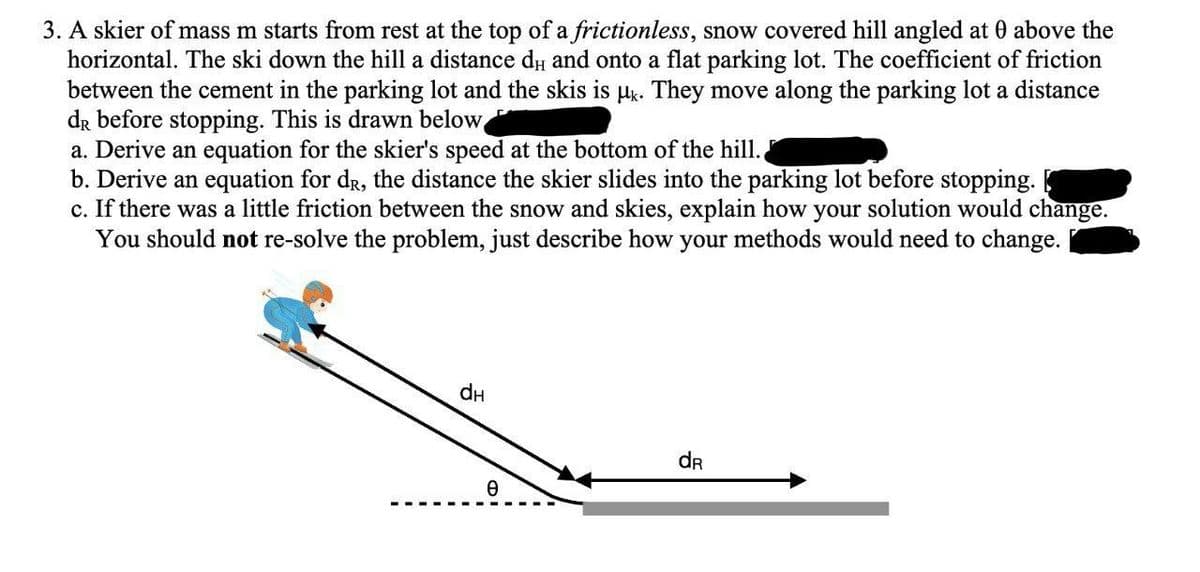3. A skier of mass m starts from rest at the top of a frictionless, snow covered hill angled at 0 above the horizontal. The ski down the hill a distance di and onto a flat parking lot. The coefficient of friction between the cement in the parking lot and the skis is µk. They move along the parking lot a distance dR before stopping. This is drawn below a. Derive an equation for the skier's speed at the bottom of the hill. b. Derive an equation for dr, the distance the skier slides into the parking lot before stopping. c. If there was a little friction between the snow and skies, explain how your solution would change. You should not re-solve the problem, just describe how your methods would need to change. dн e dR
3. A skier of mass m starts from rest at the top of a frictionless, snow covered hill angled at 0 above the horizontal. The ski down the hill a distance di and onto a flat parking lot. The coefficient of friction between the cement in the parking lot and the skis is µk. They move along the parking lot a distance dR before stopping. This is drawn below a. Derive an equation for the skier's speed at the bottom of the hill. b. Derive an equation for dr, the distance the skier slides into the parking lot before stopping. c. If there was a little friction between the snow and skies, explain how your solution would change. You should not re-solve the problem, just describe how your methods would need to change. dн e dR
University Physics Volume 1
18th Edition
ISBN:9781938168277
Author:William Moebs, Samuel J. Ling, Jeff Sanny
Publisher:William Moebs, Samuel J. Ling, Jeff Sanny
Chapter6: Applications Of Newton's Laws
Section: Chapter Questions
Problem 133CP: A skydiver is at an altitude of 1520 m. After 10.0 seconds of free fall, he opens his parachute and...
Related questions
Question

Transcribed Image Text:3. A skier of mass m starts from rest at the top of a frictionless, snow covered hill angled at 0 above the
horizontal. The ski down the hill a distance du and onto a flat parking lot. The coefficient of friction
between the cement in the parking lot and the skis is μk. They move along the parking lot a distance
dR before stopping. This is drawn below
a. Derive an equation for the skier's speed at the bottom of the hill..
b. Derive an equation for dr, the distance the skier slides into the parking lot before stopping.
c. If there was a little friction between the snow and skies, explain how your solution would change.
You should not re-solve the problem, just describe how your methods would need to change.
dH
e
dR
Expert Solution
This question has been solved!
Explore an expertly crafted, step-by-step solution for a thorough understanding of key concepts.
This is a popular solution!
Trending now
This is a popular solution!
Step by step
Solved in 2 steps with 2 images

Knowledge Booster
Learn more about
Need a deep-dive on the concept behind this application? Look no further. Learn more about this topic, physics and related others by exploring similar questions and additional content below.Recommended textbooks for you

University Physics Volume 1
Physics
ISBN:
9781938168277
Author:
William Moebs, Samuel J. Ling, Jeff Sanny
Publisher:
OpenStax - Rice University

University Physics Volume 1
Physics
ISBN:
9781938168277
Author:
William Moebs, Samuel J. Ling, Jeff Sanny
Publisher:
OpenStax - Rice University